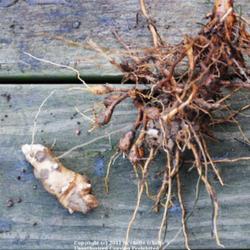Everyone has grown the venerable Sunflowers (Helianthus annuus), but did you know that this genus of plants includes a perennial that belongs in every garden?
Sunroots (Helianthus tuberosus), also known as sunchokes or Jerusalem Artichokes, are actually perennial sunflowers! Sporting the same familiar (but small) sunflower blooms, they reliably come back from their roots year after year with lush foliage and hundreds of cheerful flowers. Following the principles of permaculture, the plants in a self-sufficient garden should all have multiple uses, and the sunroots really shine in this department.
The roots are edible and have numerous uses! Once frosts have killed off the top growth, dig around under the plant and pull out small tubers, the size of large new potatoes. These can be scrubbed clean, sliced and eaten fresh, or sautéed in butter or lightly roasted in a pan. There are recipes on the internet for making a cream of sunroot soup that is excellent over pasta. The flavor of the tubers resembles water chestnuts. Recipes calling for carrots or potatoes can often use sunroot tubers instead. They can also be dried and ground into a flour that can be mixed up to 50/50 with wheat flour. Or use the dry tubers as a coffee substitute. Alcohol can be brewed from sunroot tubers and there is a potential for these to become a fuel crop. Yes, the list goes on and on.

Plant them in a permanent location! If you get the sterile varieties, they will not spread so easily, but they are difficult to eradicate once planted, so you can't get rid of them easily. Every little tuber will sprout in the spring, so choose a site in full sun with average soil and you'll enjoy them forever. If you do decide to get rid of them entirely, fence the area and let your pigs or chickens spend a season in there.
These robust plants with heavy foliage and dense root systems easily out-compete other plants, even invasive ones. Planted in a row, they act as a wall, hindering the spread of invasive species like bermuda grass. Along those same lines, the sunroots can form a suitable windbreak.
Grow beans, peas, cucumbers or other lightweight climbers around your sunroots and let them grow up together. The sunroot will enjoy the companionship and the climbing vines will enjoy the support. You will enjoy not having to put up a trellis system! This is a good example of a plant guild.